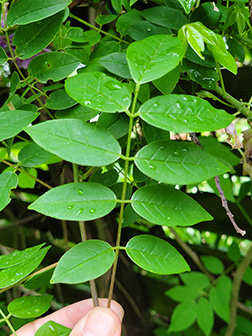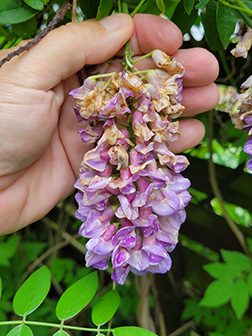 Virginia Tech Dendrology
Virginia Tech Dendrology
American wisteria Fabaceae Wisteria
frutescens (L.) Poir.
![]()
![]() symbol: WIFR
symbol: WIFR
Leaf: Alternate, pinnately compound, 7 to 12 inches overall, with 9 to 15 ovate to lanceolate leaflets each 2 to 3 inches long with entire (not undulating) margins and wedge-shaped tips, dark green above.
Flower: Very showy, lilac with a yellow spot pea-like flowers, occurring in compact (relative to the nonnatives) hanging 6 inch clusters, appearing after the leaves, flowers of one raceme opening from base to tip.
Fruit: Pea-like pods that are initially slightly fuzzy but becoming glabrous, to 5 inches long, persistent.
Twig: Slender, red-brown to gray-brown, glabrous, raised circular leaf scar, appressed triangular light brown buds.
Bark: Smooth, gray-brown.
Form: A climbing twining vine, reaching up to 40 feet in height; twines counter-clockwise.
Looks like: Japanese wisteria
- Chinese wisteria
- trumpet creeper
Additional Range Information: Wisteria frutescens is native to North America. Range may be expanded by planting. Download the full-size PDF map.
External Links: USDA Plants Database
All material 2025 Virginia Tech Dept. of Forest Resources and Environmental Conservation; Photos and text by: John Seiler, Edward Jensen, Alex Niemiera, and John Peterson; Silvics reprinted from Ag Handbook 654; range map source information




